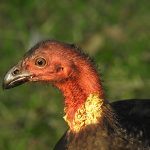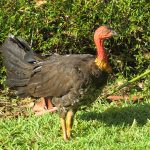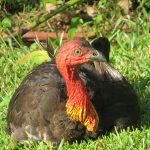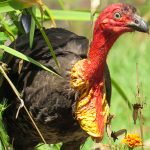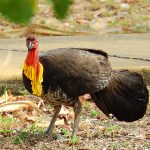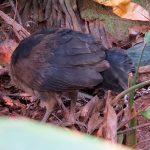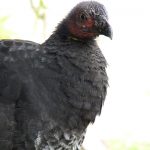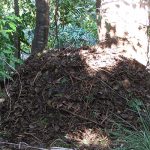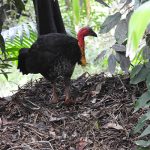AUSTRALIAN BRUSH-TURKEY
Alectura lathami
In the gentle dawn light of Australia’s eastern forests, if you listen carefully, you might hear a gentle rustling among the leaf litter. This is often the sign of one of Australia’s most fascinating and resilient birds: the Australian Brush-turkey. Sometimes called the scrub turkey or bush turkey, this large, ground-dwelling bird has won both admiration and curiosity for its unique habits and remarkable adaptability.
With glossy black plumage, the Australian Brush-turkey strikes an impressive figure. It sports a bare, bright red head and neck—a feature more reminiscent of wild turkeys far across the ocean than most of Australia’s native wildlife. Males display a conspicuous yellow or purple wattle draped like a scarf across the throat, which swells and brightens during the breeding season.
Family and Range
- Family: Megapodiidae, also known as the ‘mound-builders.’
- Distribution: Widespread along the east coast of Australia, from Far North Queensland to New South Wales, even in suburban gardens and city parks.
Nesting Marvels
Perhaps the most celebrated attribute of the Brush-turkey is its extraordinary approach to child-rearing. Instead of sitting on eggs to brood them, the male builds massive mounds—sometimes over four metres wide and one metre tall—crafted from leaves, soil, and sticks. The heat generated by decaying organic material acts as an incubator.
- Males diligently monitor the temperature of the mound, expertly adding or removing debris to keep conditions just right, often between 33–35°C.
- Females lay eggs in the mound, then leave incubation to the warmth of compost, and the male’s meticulous maintenance.
- Chicks hatch fully feathered and independent, receiving no parental care as they make their first journey into the world alone.
Adaptation to Urban Life
Once shy, Brush-turkeys now thrive in urban environments. They are a common sight in gardens and parks, often seen raking mulch into unruly piles with robust claws. Some find their antics endearing, while others are frustrated by their rearrangement of carefully tended flower beds.
Ecological Role and Conservation
- Role in the Ecosystem: Brush-turkeys are nature’s gardeners, recycling nutrients through their mound-building habits, which aerate the soil and help seeds to germinate.
- Population Status: Not threatened; their adaptability has ensured healthy numbers, especially in areas with plenty of food and shelter.
- Human Interactions: While their behaviour can conflict with landscaping efforts, these birds are protected by law. Ethical coexistence is encouraged, recognising their essential role in Australian bushland.
The story of the Australian Brush-turkey is one of survival and balance. By turning gardens into foraging grounds and finding new ways to coexist with humans, they offer a living example of adaptation in a changing world. Protecting their habitats—both in the bush and suburbs—ensures the Brush-turkey continues to play its part in Australia’s ecological tapestry.
The Australian Brush-turkey, with its striking looks and quirky lifestyle, serves as a reminder of nature’s inventiveness. By observing and appreciating their behaviours, we not only witness one of Australia’s unique ecological stories but also discover the value of embracing and preserving wildlife, even in the spaces we share.
If you notice a brush-turkey in your local park or garden, take a moment to watch its methodical movements and spirited foraging. In doing so, you’re connecting with a distinctive chapter of Australia’s wild story—and becoming part of the ongoing narrative of coexistence.

